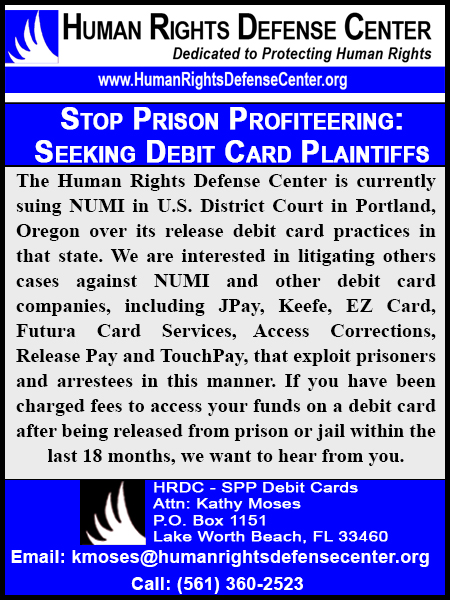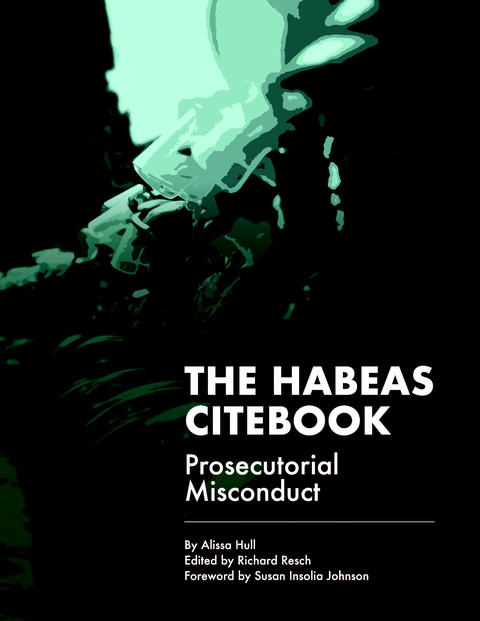×
You've used up your 3 free articles for this month. Subscribe today.
Federal Habeas Corpus: How to Raise a Fourth Amendment Claim
by Dale Chappell
The slam dunk for federal habeas claims, if such a thing exists, would be a claim that successfully challenges the evidence in a criminal case. By tossing the unlawfully-obtained evidence, not only would the conviction be overturned, but the prosecution wouldn’t have a case for a new ...
Full article and associated cases available to subscribers.
As a digital subscriber to Criminal Legal News, you can access full text and downloads for this and other premium content.
Already a subscriber? Login
More from this issue:
- They Called 911 for Help. Police and Prosecutors Used a New Junk Science to Decide They Were Liars., by Brett Murphy
- Indiana Supreme Court: Defendant Who Was Both Victim of Crime and Suspect in Unrelated Crime Entitled to Pirtle Warning Prior to Police Asking for Consent to Search Home, by Anthony Accurso
- Federal Habeas Corpus: How to Raise a Fourth Amendment Claim, by Dale Chappell
- Seventh Circuit: State Court Decision Not Entitled to AEDPA Deference Due to Incorrect Legal Standard, Pro Se Habeas Petition Granted Based on Trial Counsel’s Failure to Present Expert Witness on Determinative Issue of Guilt Resulting in IAC, by Jacob Barrett
- Colorado Supreme Court: Police Lacked Reasonable Suspicion for Traffic Stop Based on Alleged Unsafe Lane Change, by Anthony Accurso
- California Court of Appeal: Right to Withdraw Plea 23 Years After Entered Because Counsel Failed to Properly Advise of Immigration Consequences and Defendant Mistakenly Believed Permanent Resident Status Barred Adverse Immigration Consequences, by David Reutter
- California Court of Appeal Affirms Grant of Suppression Motion Where Officer’s Pat Search of Defendant Based on High Crime Area, Baggy Clothes, Criminal Record, and Suspect in Separate Case, by Douglas Ankney
- New Jersey Supreme Court: Edwards Violation When Police Fail to Cease Interrogation After Suspect Makes Ambiguous Invocation of Right to Counsel and ‘Initiates’ Request for Further Communication with Police, by Jacob Barrett
- Missouri Supreme Court: Use of Out-of-Court Statement Admitted at Trial Exceeded Limited Purpose of Exception to Rule Against Hearsay Upon Which It Was Admitted, by Matthew Clarke
- Your Car Knows a Lot About You, and the Police Are Listening, by Michael Thompson
- Ohio Supreme Court: Defendant Has Reasonable and Legitimate Basis to Withdraw Guilty Plea Before Sentencing When He Discovers Evidence That Would Have Affected Decision, by Douglas Ankney
- California Court of Appeal: ‘Actual Killer’ Under Felony-Murder Rule Means Person ‘Who Personally Killed the Victim”, by Harold Hempstead
- Attorney General Garland Orders Federal Prosecutors to End Sentencing Disparities Between Crack and Powder Cocaine, by Matthew Clarke
- Governor of Oregon Leaves Legacy of Reformation While Leaving Office, by Kevin Bliss
- Nevada Supreme Court: Trial Court Erred in Denying Motion to Substitute Counsel Where Ample Evidence Showed Counsel Was Unprepared and Motion Timely, by Harold Hempstead
- Seventh Circuit: Defendant Entitled to Present Entrapment Defense Where ‘Some Evidence’ Exists of Government Inducement and Lack of Predisposition to Commit Crime, by Douglas Ankney
- California Court of Appeal: Trial Court’s Denial of Faretta Request Without Finding of ‘Severe Mental Illness’ Denied Defendant Sixth Amendment Right to Self-Representation, by Matthew Clarke
- Minneapolis Police Department Surveillance Operation Kneels on the Neck of the First Amendment, by Casey Bastian
- Ninth Circuit: No Qualified Immunity for Detective Who Arrested Anti-Police-Slogan Sidewalk Chalkers, but Not Other Chalkers Whose Content Wasn’t Anti-Police, Even Though There Was Probable Cause to Arrest, by Matthew Clarke
- Massachusetts Supreme Court: Commonwealth Failed to Show GPS Monitoring as Condition of Probation Is Constitutional, by Anthony Accurso
- Sixth Circuit Announces Nonretroactive Change in Sentencing Law Is Not an ‘Extraordinary and Compelling Reason’ Warranting a Sentence Reduction under Compassionate Release Statute, by Douglas Ankney
- Oregon Supreme Court: Federal Law Prohibits Elected DA’s Delegation of Wiretap Authority and Overbroad Initial Search Warrant Requires Suppression of Evidence Obtained as Result of Over 20 Subsequent Warrants, by Mark Wilson
- Invasions of Privacy for People on Electronic Monitoring Is a Warning of Worse Things to Come, by Benjamin Tschirhart
- The District of Colombia: Inside the Most Expansive Surveillance Network in America, by Casey Bastian
- Florida Supreme Court Settles Circuit Split, Holding Dual DUI Convictions Regarding Single Victim in Single Incident Violates Double Jeopardy, by David Reutter
- Houston Cop from Fatal Raid Lied in Other Cases, by Jayson Hawkins
- Electronic Freedom Foundation’s Atlas of Surveillance Helps You Watch Those Who Watch Us, by Michael Thompson
- Was the DNA at the Crime Scene Left by the Perpetrator – or by a Pet?, by Douglas Ankney
- New York Police Department Joins Crowdsourced Surveillance Ring Neighbors App, by Michael Thompson
- Registry of Approved Standards Adds Two New 3D Firearm Analysis Standards, by Casey Bastian
- FBI Heist Made Public, by Jayson Hawkins
- New San Francisco Ordinance Allows Police to Access Private Security Cameras, by Kevin Bliss
- Cruel and Unusual: Residency Restrictions Force Registrant to Die Among Strangers, by Eike Blohm, MD
- News in Brief
More from Dale Chappell:
- How to Take Your Postconviction Case Directly to the U.S. Supreme Court: A Roadmap to Direct Collateral Review, March 15, 2025
- Federal Habeas Corpus for State Prisoners: Proving Unreasonableness Under AEDPA, Feb. 1, 2025
- Federal Court Rules Michigan’s Sex Offender Registration Laws Violate Constitution, Dec. 1, 2024
- Refuting the Government’s Argument Against Nonretroactive Changes in Law as Grounds for Compassionate Release, Oct. 1, 2024
- Federal Habeas Corpus: Getting Around Procedural Default, July 15, 2024
- The Death of the Savings Clause, May 15, 2024
- Federal Habeas Corpus: Understanding Second or Successive Petitions for State Prisoners, April 15, 2024
- Fourth Circuit Reinstates Relief From Death Penalty, Citing State’s Forfeiture of Argument Against Relief, May 15, 2023
- Federal Habeas Corpus: The Evidentiary Hearing for Federal Prisoners, April 15, 2023
- Federal Habeas Corpus: How to Raise a Fourth Amendment Claim, Feb. 15, 2023
More from these topics:
- Ninth Circuit Grants Stay and Abeyance of Federal Habeas Petition to Allow Petitioner to Exhaust State Remedies, April 15, 2025. Administrative Exhaustion (PLRA), Habeas Corpus, AEDPA, Amendments to Petition.
- Federal Government Circumventing Fourth Amendment by Buying Data From Data Brokers, April 15, 2025. Databases, Searches - Cellphones/Computers/Internet, Immigration Law/Offenses, Fourth Amendment.
- Third Circuit Grants Habeas Relief to Prisoner on Confrontation Clause and Ineffective Assistance Claims Based on Trial Court Reading Entire Criminal Information Into the Record of Co-Conspirator Who Pleaded Guilty, Feb. 15, 2025. Habeas Corpus, Ineffective Assistance of Counsel, Exculpatory No Doctrine, Confrontation Clause/Rights, Witnesses - Prior Statements/Testimony, Plea Agreements/Guilty Pleas.
- Texas Court of Criminal Appeals Grants Habeas Relief in ‘Shaken Baby Syndrome’ Case, Feb. 1, 2025. junk science, Habeas Corpus, Forensic Sciences, Child Abuse/Abusers, Evidence - Admissibility.
- California Prisoner Awarded Over $1.26 Million in Suit Challenging Withheld Legal Mail Which Resulted in Habeas Loss, Jan. 15, 2025. Settlements, Habeas Corpus, Mail Regulations, Legal Mail.
- Georgia Supreme Court Grants Habeas Relief Where Both Trial and Appellate Counsel Provided Ineffective Assistance by Failing to Challenge Indictment for Residential Burglary That Failed to Allege Defendant Illegally Entered a ‘Dwelling’, Jan. 15, 2025. Habeas Corpus, Ineffective Assistance of Counsel, Constitutional Challenges/Law.
- Ninth Circuit Holds District Courts Have No Authority Under Rule 4 of Rules Governing § 2254 Cases to Dismiss Habeas Petition on the Merits, Dec. 15, 2024. Habeas Corpus, Dismissal, Authority and Jurisdiction.
- Ninth Circuit Grants Habeas Relief to California Prisoner on Napue Claim Because Prosecution Failed to Correct Informant’s False Testimony That He Did Not Receive Any Benefit In Exchange for His Testimony, Dec. 1, 2024. Informants, Habeas Corpus, Informants and Paid Witnesses, False Testimony.
- Public Defender Files Habeas Petitions for Detainees at “Horrific” Baltimore Lockup, Nov. 15, 2024. Failure to Treat, Conditions of Confinement, Hygiene Supplies, Disclosure of Records, Habeas Corpus.
- Ninth Circuit Denies Habeas Relief to Prisoner Who Invoked Fifth Amendment Right to Counsel During Custodial Interrogation but Made Incriminating Statements to Undercover Informant Posing as Fellow Prisoner Because Right to Counsel Not Violated, Nov. 1, 2024. Habeas Corpus, Custodial Interrogations/Statements, Counsel - Right to.





